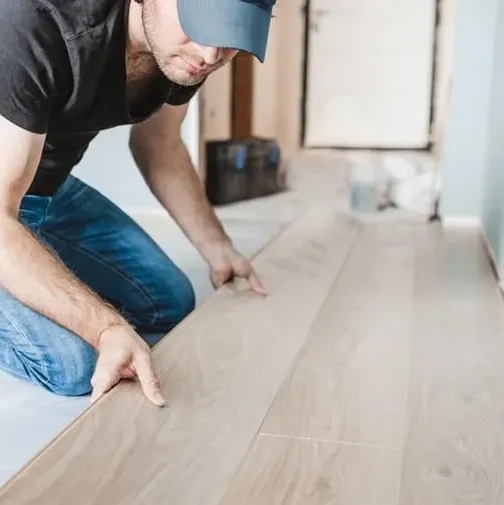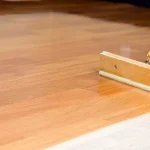- September 26, 2024
Bubbling occurs due to moisture exposure, poor installation, or inadequate maintenance. Understanding the causes of laminate floor bubbling is crucial. It helps both prevent and address the issue. It ensures your flooring stays in top condition for years.
Laminate flooring is a popular choice for homeowners. Laminate flooring has both pros and cons. It’s known for being affordable, durable, and aesthetically appealing. However, like any flooring material, it can develop issues over time. One of the most common problems is laminate floor bubbling. It occurs when sections of the laminate surface swell or lift. It disrupts the smooth, even finish of the floor. But why this happens?
In this article, we’ll give you all the answers to understand what exactly causes laminate bubbling and how you should fix it.
What Is Laminate Floor Bubbling?
Laminate floor bubbling occurs when parts of the laminate surface swell. The surface can also rise or form air pockets. It creates an uneven, bumpy texture. The problem often arises due to moisture seeping into the laminate layers. Moisture can come from spills, humidity, or improper cleaning methods. Poor installation can also cause bubbling. For example, insufficient expansion gaps between the laminate and walls can lead to pressure buildup. As the flooring expands, this pressure can cause bubbling.
Also Read: Different Laminate Flooring Patterns
Common symptoms include visible bulges or lifted areas. There may also be difficulty maintaining a smooth surface. Sometimes, you might hear a crackling sound when walking on the floor.
Detecting these signs early is crucial to prevent further damage. If ignored, bubbling can worsen. It may lead to more extensive repairs. In some cases, it might even require replacing entire sections of the flooring. Recognizing these symptoms allows homeowners to act quickly, preserving their laminate floors.
What Are the Causes of Laminate Floor Bubbling
Identifying the underlying causes of laminate floor bubbling is essential. It helps address the issue and maintain a pristine floor surface.
Moisture and Humidity
Moisture and humidity are significant contributors to laminate floor bubbling. Excessive humidity can cause laminate planks to swell. It happens because the planks absorb moisture from the air. Improper cleaning products can also cause problems. Products that are too wet can introduce moisture to the laminate. Harsh chemicals in cleaning products can also cause this issue.
Also Read: Laminate vs. Solid Hardwood: Which is Better?
These environmental factors disrupt the laminate’s adhesive bond. As a result, the planks expand and warp. To prevent these issues, maintain proper humidity levels. Additionally, use cleaning methods that don’t over-saturate the floor.
Installation Errors
Installation errors can lead to laminate floor bubbling. One primary cause is the lack of expansion gaps. Laminate floors need space around the edges to expand and contract. This space is essential to accommodate changes in temperature and humidity. Without these expansion gaps, the planks may buckle and form bubbles. And it’s guaranteed that if the flooring installation handles a professional company, chances are low that you’ll face laminate bubbling issue in the future. That’s another reason to hire a professional flooring installation company.
Also, subfloor issues and improper vapor barriers can exacerbate the problem. An uneven or poorly prepared subfloor can create pressure points. Inadequate vapor barriers can allow moisture to seep through, affecting the laminate. Proper installation techniques are essential to prevent these issues.
Poor Quality Materials
Poor quality materials can significantly contribute to laminate floor bubbling. Lower-grade laminates often lack durability and resistance to moisture and temperature fluctuations. As a result, these inferior materials are more susceptible to swelling and bubbling.
Cheaper laminates may have less effective bonding agents and may not adhere properly. It allows air and moisture to get trapped beneath the surface. Investing in high-quality laminate flooring helps avoid these problems. It provides better resistance to environmental changes. Choosing reputable brands ensures a longer-lasting and more stable floor.
Common Areas Where Bubbling Occurs
Bubbling in laminate floors commonly occurs in specific areas. It is due to varying environmental factors.
- High-traffic areas are particularly vulnerable. Constant foot traffic can exacerbate underlying issues. These issues may include insufficient expansion gaps or subfloor problems.
- Bathrooms and kitchens are prone to bubbling due to their higher moisture levels. Increased humidity from sinks, showers, and cooking contributes to this issue. The laminate absorbs excessive moisture, causing it to swell and bubble.
- Areas near windows or doors are susceptible due to frequent temperature fluctuations. These changes can cause the laminate to expand and contract more than in other areas. As a result, warping and bubbling can occur.
Proper installation and regular maintenance are important. Monitoring environmental conditions can also help. These steps can mitigate issues and preserve the integrity of your laminate flooring in commonly affected areas.
How to Fix Laminate Floor Bubbling
Knowing how to fix laminate floor bubbling effectively is important. It can restore the smooth, pristine look of your laminate surfaces. It can also extend their lifespan.
Method 1: Repairing with Wood Glue or Wax
Wood glue or wax can be effective for minor bubbling issues in laminate floors. Using these methods can help repair the problem.
- Start by cleaning the affected area thoroughly to remove any dust or debris.
- Next, gently lift the bubbled section of the laminate using a flat tool. Be careful not to damage the surface.
- For wood glue, apply a small amount under the lifted laminate.
- Then press it down firmly to spread the glue evenly.
- Use a heavy object to keep the laminate in place while the glue dries, typically for 24 hours.
If using wax, apply a small amount to the bubbled area and smooth it with a soft cloth. The wax fills in the gap and helps to level the surface. Allow it to set as per the manufacturer’s instructions.
Method 2: Replacing Damaged Planks
To fix bubbling, begin by identifying and isolating the damaged planks.
- First, carefully remove the baseboards or trim around the affected area.
- Use a utility knife to cut through adhesive or sealant around the damaged planks.
- Gently lift the damaged planks, starting from one corner. Carefully remove them from the flooring.
- Once removed, inspect the subfloor for any moisture or damage. Make necessary repairs before proceeding.
- Place a new plank in the gap, ensuring it matches the existing flooring in style and color.
- Fit the new plank into place. Secure it with the appropriate adhesive or by clicking it into a floating floor system, if applicable.
- Reinstall the baseboards or trim, making sure everything is flush and secure.
Method 3: Creating Expansion Gaps
Creating expansion gaps prevents bubbling caused by installation errors.
- Begin by identifying areas where the laminate planks are too close to the walls. Check for any other obstacles as well.
- Use a spacer tool to create the necessary gap between the edge of the laminate and the wall. This gap allows the laminate to expand and contract. It accommodates changes in temperature and humidity without causing bubbles or warping.
- Carefully remove any baseboards or trim if necessary to create sufficient space.
- Once the gaps are established, reattach the baseboards or trim. Ensure they do not press against the laminate. This adjustment helps to relieve pressure and prevent further bubbling.
Preventing Laminate Floor Bubbling
Preventing laminate floor bubbling starts with ensuring professional installation. Expert installers are skilled at creating the necessary expansion gaps. They also prepare the subfloor properly. It reduces the risk of bubbling due to installation errors.
To maintain laminate flooring, control humidity levels within your home. Keep indoor humidity between 30-50%. It prevents the laminate from absorbing excess moisture. Using a dehumidifier or air conditioner can help manage humidity levels. It is instrumental in areas prone to high humidity.
Additionally, choose appropriate cleaning products and methods to protect your laminate floors. Avoid excessive water or harsh chemicals. They can damage the laminate and cause moisture to seep underneath. Instead, use a damp mop and mild, laminate-specific cleaners. Regularly sweep or vacuum to remove debris that can scratch the surface.
Our Recommendations
Laminate floor bubbling is a common issue caused by various factors. They include moisture, installation errors, and poor-quality materials. Understanding the root causes is crucial for effective repair. These causes include improper humidity control, inadequate expansion gaps, and defective planks.
You can address minor bubbling with wood glue or wax. More significant issues may require plank replacement. Creating proper expansion gaps might also be necessary. Prevention is key. Ensure professional installation, maintain appropriate humidity levels, and use suitable cleaning methods.
Ready to get started with your home renovation with the best flooring company in Sunnyvale? Contact us, and our professionals will love to help you with your choice and price estimate.
If your laminate floor starts bubbling, first identify the cause. It can be a moisture or an installation issue. For minor bubbling, use wood glue or wax to repair it. For more significant issues, replace damaged planks or create proper expansion gaps. Ensure proper humidity levels and use appropriate cleaning methods.
Yes, you can prevent bubbling in high-humidity areas. Maintain indoor humidity levels between 30-50%. Use a dehumidifier or air conditioner. Ensure proper installation with adequate expansion gaps. Additionally, use appropriate cleaning methods to avoid excess moisture on the laminate.
Laminate floor bubbling repairs can last several years if done correctly. Properly addressing the cause of bubbling is important. It includes issues like moisture or installation problems. Using quality repair methods will ensure the longevity of the fix. Regular maintenance can also help. Managing environmental conditions will extend the effectiveness of the repairs.
No, it’s not necessary to replace all laminate planks if only a few are bubbling. You can replace just the damaged planks. However, ensure the underlying issues are addressed to prevent further bubbling. Proper repair and maintenance can help avoid the need for widespread replacement.




